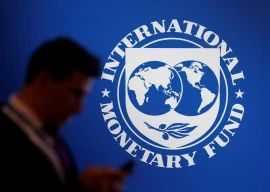
The International Monetary Fund (IMF) on Monday did not immediately endorse the interim government’s proposals to reduce industrial electricity prices, settle over one-fifth of the circular debt and make the Rs268 billion debt of the Pakistan International Airline (PIA) part of the public debt.
The IMF also asked as to why the interim government is showing haste when the Election Commission of Pakistan (ECP) has already barred it from taking any decisive action on the privatisation of PIA, according to government sources.
The global lender sought more details about the economic and legal viability of the three major proposals. The IMF held two back-to-back virtual meetings but their outcomes were below the expectations of the Pakistani authorities.
The next round of discussions on these proposals would take place after the Pakistani authorities provide additional information and the global lender reviews it internally.
The IMF neither rejected nor accepted the three proposals. It emerged from these two meetings that the IMF would give more serious thoughts to them once an elected government takes charge.
The caretaker government is keen on getting the three proposals implemented before leaving the office.
The meetings took place on the request of Pakistani authorities just three days before the general elections scheduled for this Thursday.
The ECP on Sunday refrained the interim government from taking anything to the federal cabinet related to the PIA privatization and questioned its legal mandate.
The spokesman of the Ministry of Finance, Qamar Abbasi did not respond to a question about the IMF’s response to the proposals and sought more information. The IMF resident representative, Esther Perez, also did not reply.
The sources said the IMF’s main objection to the PIA’s proposed debt settlement plan was about the urgency in taking the PIA debt into the government’s books. The government was claiming that the entity was ripe for privatisation and its future proceeds would be available to pay off the debts but still it wanted to take the Rs268 billion on its books before the end of the caretaker setup.
The IMF wanted further clarity about the likely timing of the PIA privatisation and the minimum reserve price, if any, worked out by now by financial advisors. The sources said the IMF’s query was why not to wait for the PIA privatisation proceeds to settle the debt.
The sources said that there was also a question on the treatment of the PIA’s debt that it owes to the Civil Aviation Authority (CAA), the Federal Board of Revenue (FBR) and the Pakistan State Oil (PSO).
The IMF was informed about the arrangement among the commercial banks and the federal government about the Rs268 billion debt restructuring. The government and commercial banks had agreed on the Rs268 billion debt restructuring plan.
Under the understanding, the government will use the PIA sale proceeds for principal payments, resorting to the budget if insufficient funds are available. Banks, in return, accept a 10-year debt rollover with a 12% annual interest rate, amounting to Rs32.2 billion in annual interest payments.
Read: Govt post-polls: Businesses see IMF, SIFC holding key to better future
This arrangement means banks will receive Rs322 billion in interest payments over a decade, exceeding their outstanding stocks of Rs268 billion. The total payout to banks at a 12% interest rate will be Rs572 billion in 10 years.
The total outstanding debt of the airline is Rs825 billion, and the privatization ministry and the PIA have to seek no objection certificates from the CAA and the FBR to file a scheme of arrangement with the Securities and Exchange Commission of Pakistan (SECP).
The PIA owes Rs120 billion to the CAA. The FBR needs to recover Rs19 billion from the PIA.
Tariff Plan
The sources said the IMF also did not give its stamp of approval to the government’s plan of reducing the electricity prices for the industrial sector with effect from April 1. For the IMF, it was like reducing the burden from one shoulder and putting it on another, which is already overburdened.
The plan reduces the cross-subsidy burden of the industrial sector by 91% or Rs222 billion but it increases the subsidy burden on residential consumers using over 400 units by 41% or Rs22 billion.
Pakistani authorities informed the IMF about their plan to reduce industrial tariffs up to 29% by sparing the industrialists from the burden of paying subsidies for the majority of the domestic consumers.
The industrial consumer pays Rs8.61 per unit subsidy, while the residential consumer with consumption above 400 units pays Rs5.88 per unit.
The energy ministry has proposed fixed charges on all types of residential consumers to reduce cross-subsidy for industrial consumers, ranging from as low as Rs50 fixed charge on 50 units monthly consumption, to Rs3,000 per month fixed charges for unprotected residential consumers with monthly consumption ranging from 1 unit to above 700 units. These changes would lead to an overall effective industrial tariff ranging from 8.5 cents per unit to 11.75 cents per unit.
CD Plan
The IMF also decided to hold a separate meeting with the minister for energy to get further clarity on the Rs1.27 trillion circular debt reduction plan.
The global lender was briefed about the plan to reduce the circular debt by Rs1.27 trillion or 22% through combination of budget subsidies and using the government companies’ dividends.
The total energy sector circular debt stands at Rs5.725 trillion as of November 2023. This includes Rs2.7 trillion power sector debt and over Rs3 trillion gas sector debt.
The IMF wanted to understand the government’s legal obligation in paying the Rs745 billion supplementary grant to settle the circular debt.
The IMF was told that a grant of Rs745 billion was needed for only two days to trigger the entire process. The actual funds that would go back to the kitty in the shape of dividends and taxes would be Rs748 billion, they claimed in the plan submitted to the SIFC.
The gross impact on the budget of the Rs1.27 trillion circular debt plan will come to Rs902 billion.
Of the debt settlement plan of Rs1.27 trillion, it is proposed to retire a little over Rs1 trillion of the gas sector circular debt. The remaining over Rs255 billion will be spent on curtailing the power sector circular debt of Rs2.7 trillion.
Once implemented, the gas sector debt will come down from over Rs3 trillion to Rs2 trillion. The power sector circular debt will drop to Rs2.5 trillion.

1737453189-0/fizza-(65)1737453189-0-405x300.webp)


1737448163-0/BeFunky-collage-(15)1737448163-0-165x106.webp)
1737104486-0/fizza-(46)1737104486-0-165x106.webp)
1737453053-0/sidra--(67)1737453053-0-270x192.webp)

1737452190-0/sidra--(66)1737452190-0-270x192.webp)

















COMMENTS (1)
Comments are moderated and generally will be posted if they are on-topic and not abusive.
For more information, please see our Comments FAQ